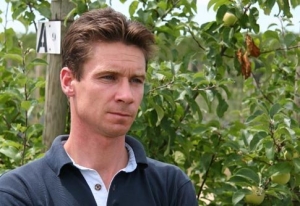
Emmanuel de Lapparent
Europe now has close to 30 managed or club varieties supported by marketing groups. The explosion of managed varieties around the world since Pink Lady Europe was organized a decade ago has changed both the dynamics of releasing new varieties and the success rate.
“Clubs are now the major way for commercial varieties to come to Europe,” said Emmanuel de Lapparent, manager of International Fruit Obtention, a private variety development company that represents three major French nurseries.
“There’s a lot of investment in these managed varieties, and the groups all want the same things—a high-level price and market presence,” said Philippe Toulemonde, chair of Star Fruits, a variety development group in France that was behind the club variety strategy for Pink Lady.
But with fewer supermarket chains and more new releases, it is much harder to obtain shelf space now with a new variety, even when supported by a marketing plan, he said.
“We have to think of a new way for variety development,” Toulemonde said. “Pink Lady was one way, and it has worked well,” he said, noting that it succeeded in part because of product differentiation and the partnership of Australia and other countries. “We see that if you have a really special and unique product, it works. But if the product is middle quality, it will be very tough. We need to think about another way of pushing new varieties.”
Winners
With so many new varieties under evaluation, picking a winner is a complex process, requiring years of field evaluation and trials. All agree that not just any selection is a candidate for a new variety or managed program.
How do you choose those varieties that have club potential? Thierry Ligonnierre, nursery sales manager for Davodeau-Ligonniere Nursery in Angers, France, said that a variety must have “charm and originality.”
Not only does the variety need to be different, but it must be productive and profitable for the long haul, Ligonniere said. “It can have a great taste, but if production suffers and it’s not a good producer, there will be long-term problems. You need to find profit in the variety.”
For example, Honeycrunch (Honeycrisp) is a great apple, he explained, and there is great profit right now. But the variety has low packouts of around 50 percent. When high retail prices for the variety eventually drop, producers will struggle to make a profit with the apple, he warned. Another example is Tentation (Delblush), a French-bred apple that has fantastic taste, but can bruise easily and also have low packouts.
Ligonniere said that a winning variety also needs a leader. “You need someone who believes in the variety and has a vision for it.” He notes that the successes of Pink Lady and Jazz are in part due to the developers behind the varieties.
He is critical of some variety clubs that are more of a nursery plan, putting volume before marketing, or allowing the variety to be grown in many different climates, which can impact fruit consistency and quality.
Also, some clubs are designed for a very narrow marketing niche, which may or may not be large enough, he said. Production of the French variety Choupette, a scab resistant, late season apple, amounts to only 5,000 tons in France. While it may eventually have the interest of international growers, it is a small program thus far. “Can it really be a notable variety with only 5,000 tons?” Ligonniere asked.
IFO’s de Lapparent said three things are required for a winning club variety: “To be successful, you need an outstanding variety that is better than current ones, you need growers to plant the variety, and you need marketers to promote it.”
Club varieties, though popular in Europe, are not the only way for a new variety to be successful, said de Lapparent, adding that some growers are still reluctant to join managed programs. Although he believes there is still a place for open varieties, he is not sure how they will successfully enter the market in the future.

Leave A Comment